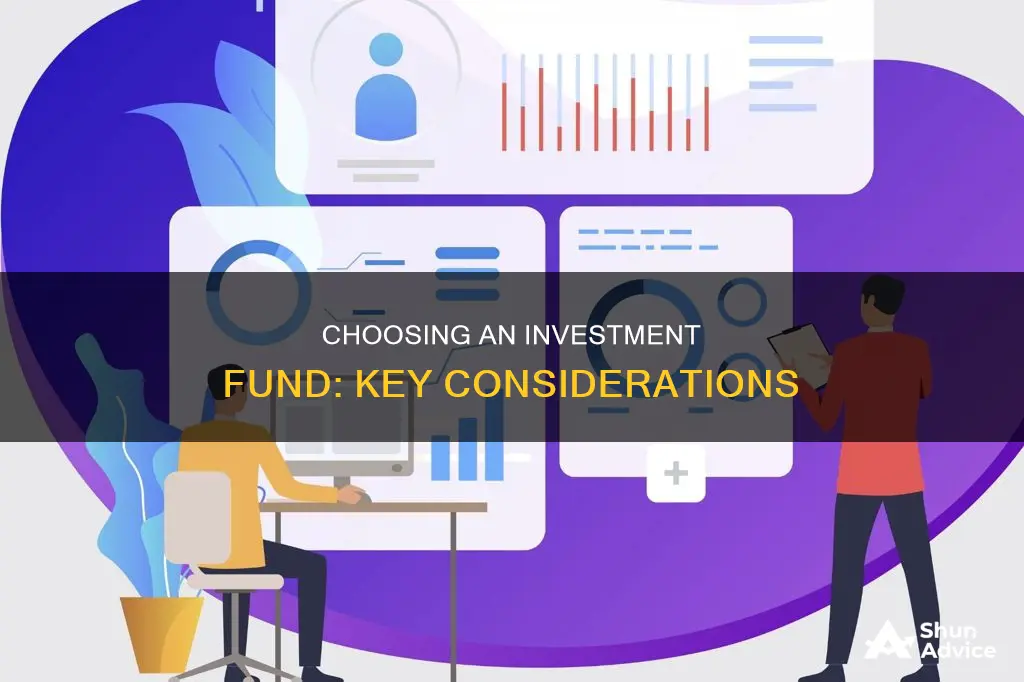
Investing in funds is a popular way to improve your savings returns, but it's not without risk. Before investing in any fund, it's important to identify your goals and risk tolerance. Are you investing for long-term capital gains or current income? Can you accept dramatic swings in portfolio value, or do you require a more conservative investment?
There are thousands of funds to choose from, so it's important to do your research. Key things to consider include the fund's objectives, the level of risk, the fund manager's investment strategy, independent ratings, and fees.
It's also important to remember that past performance does not guarantee future success, and that investing is generally a long-term option—you should invest for at least five years to ride out any bumps in the market.
What You'll Learn

Understand the fund's risk level and your own risk tolerance
Understanding the risk level of a fund and your own risk tolerance is a crucial step in selecting an investment fund. Here are some detailed instructions to help you through this process:
Firstly, identify your investment goals. Ask yourself whether your objective is long-term capital gains or current income. Are you investing for a specific purpose, such as education expenses or retirement funding? Knowing your goals will help you narrow down the vast array of available funds.
Next, assess your personal risk tolerance. Consider whether you can tolerate significant swings in the value of your portfolio. Are you comfortable with a more conservative, lower-risk investment, or are you willing to take on more risk for potentially higher returns? Remember that risk and return are directly proportional, so balance your desire for returns with your ability to tolerate risk.
Also, determine your desired time horizon. How long do you plan to hold the investment? Are there any liquidity concerns or anticipated financial needs in the near future? Mutual funds often have sales charges, so to mitigate their impact, an investment horizon of at least five years is generally recommended.
When evaluating funds, consider the types of assets they invest in. Funds that purely invest in shares tend to be riskier but offer higher potential returns. If you want to reduce risk, consider funds that invest in a mix of asset classes, such as bonds.
Additionally, look at the size and stability of the companies a fund invests in. Funds that focus on large, established companies are generally seen as lower-risk compared to those investing in small, up-and-coming businesses that may be more prone to failure.
Finally, consider the geographic region of the companies in the fund. Investing in companies based in developing countries, known as emerging market funds, is usually deemed higher-risk due to the economic fragility of those regions.
Remember to always do your research and understand the risks before investing. Diversify your investments and avoid putting all your money into a single type of investment or fund. By following these steps, you can make a more informed decision about selecting an investment fund that aligns with your risk tolerance and investment goals.
Target-Risk Funds: A Guide to Investing in Your Future
You may want to see also

Compare fees and charges
When it comes to choosing an investment fund, fees and charges are an important consideration. There are a number of costs associated with funds, and these can eat into your investment returns.
Platform Charges
Firstly, the platform you choose to invest through will likely charge you a fee. This could be a monthly, quarterly, or annual account fee, either as a flat fee or a percentage of your investments. Some platforms also charge a fee for buying or selling funds, and for transferring your investments to a different provider.
Fund Management Charges
Secondly, there are the fees associated with the funds themselves. Fund management charges, or annual management charges, are calculated as a percentage of your investment and are typically higher for actively-managed funds than for passive funds. Actively-managed funds have portfolio managers who make decisions about which securities and assets to include in the fund, whereas passive funds simply track a market or index. Actively-managed funds may also be subject to additional charges such as sales fees or 'loads'. These are typically charged at the time of purchase or upon the sale of the investment, and can be as high as 8.5% of the total amount invested.
Other Charges
In addition to the charges above, investors may also be subject to '12b-1 fees'. These are baked into the share price and used for promotions, sales, and other activities related to the distribution of fund shares. By law, these fees can be as much as 1% of your investment in the fund.
Comparing Charges
When comparing charges, look at the ongoing charges figure (OCF) and the expense ratio. The OCF includes the annual management charge and other operating costs, while the expense ratio is the total percentage of fund assets that are being charged to cover fund expenses. The higher the ratio, the lower your return will be.
While charges are an important consideration, they should not be the only factor influencing your decision. It is also important to look at the fund's performance and consider whether it offers good value for money.
Mutual Funds: Why Americans Love This Investment Option
You may want to see also

Evaluate the fund manager's performance
Evaluating the performance of a fund manager is a key consideration when selecting an investment fund. Here are some detailed instructions on how to do this:
Firstly, it is important to review the fund manager's track record. Check if the manager has delivered results that align with general market returns. Also, assess the volatility of the fund relative to major indexes. A high turnover of investments may indicate higher costs and tax liabilities for investors. These factors will provide insight into the manager's performance and the fund's historical trends.
Secondly, examine the fund's prospectus to gain insights into its future prospects and the general industry and market trends that may impact its performance. Be cautious of funds that become too large, as this can hinder their ability to meet investment objectives and require a shift in their investment strategy.
Thirdly, consider the fund manager's ability to generate consistent returns. While past performance does not guarantee future results, consistency is a key indicator of a skilled fund manager. Compare the fund's performance over the last three, five, and ten years with relevant benchmarks, such as the S&P 500.
Additionally, evaluate the fund manager's investment strategy and risk management. Understand the types of assets they invest in and their level of risk tolerance. Active fund managers aim to outperform the market but often charge higher fees, while passive fund managers track a market index and typically have lower fees.
Finally, research the fund manager's qualifications, experience, and reputation. A well-established manager with a successful long-term track record may be more reliable than a newer manager. Consider using independent fund ratings, such as Morningstar or FE FundInfo, to assess the manager's performance relative to their peers.
Remember, evaluating a fund manager's performance is just one aspect of selecting an investment fund. It should be considered alongside other factors such as fees, investment objectives, risk tolerance, and your personal financial goals.
Trust Fund Investment Strategies: Where to Begin?
You may want to see also

Consider the fund's investment strategy
When considering the investment strategy of a fund, it is important to understand the fund's objectives and whether they align with your own investment goals. Each fund must explain its objectives, which can be found on the "fund factsheet" provided by the investment company.
For example, an income fund manager focuses on buying and selling stocks of companies with strong balance sheets that pay regular dividends, while a growth fund manager typically invests in companies that are expected to experience significant earnings growth over time.
Additionally, consider the level of risk you are comfortable with. This includes assessing the asset class, size of companies, and region of investment. For instance, investing in shares may carry a higher level of risk compared to investing in a mix of asset classes such as bonds.
It is also crucial to evaluate the fund's portfolio turnover rate, which measures how often the manager buys and sells securities. A high turnover rate indicates active management but may lead to higher trading costs, while a low turnover rate suggests a long-term investment approach.
Furthermore, examine the fund's investment style, which can be either actively or passively managed. Actively managed funds involve portfolio managers making decisions about which securities and assets to include, while passively managed funds, also known as index funds, aim to track and duplicate the performance of a benchmark index. Actively managed funds often carry higher fees and may be more suitable for investors seeking to outperform the market, whereas passively managed funds tend to have lower fees and are designed for those seeking steady performance.
Finally, consider the fund's performance and risk ratios, such as alpha, beta, volatility, and the Sharpe ratio, to assess the manager's skill and the level of risk being taken.
Jim Rogers' Commodity Fund: A Guide to Investing
You may want to see also

Diversify your portfolio
Diversifying your portfolio is a crucial aspect of reducing risk and enhancing the performance of your investments. Here are some essential insights to guide you in diversifying your portfolio effectively:
- Asset Allocation: Diversification goes beyond investing in different companies; it also involves allocating your investments across various asset classes. This means investing in a range of options such as stocks, bonds, real estate, commodities, and cash. By spreading your investments across multiple asset classes, you reduce the impact of any single asset class on your portfolio's performance.
- Sector and Industry Exposure: Diversifying across different sectors and industries is vital. Different sectors and industries tend to perform differently under various economic conditions. For example, during an economic downturn, defensive sectors like utilities and consumer staples tend to be more resilient, while cyclical sectors like consumer discretionary and financials may be more vulnerable. Ensure you have a mix of sectors and industries in your portfolio to reduce the potential impact of sector-specific risks.
- Geographic Diversification: Investing in companies or funds from different countries and regions is another essential aspect of diversification. Different countries and regions have distinct economic cycles, currency values, and market conditions. By diversifying geographically, you can reduce the impact of country-specific or region-specific risks, such as political instability, economic downturns, or natural disasters, on your portfolio.
- Risk and Return Profile: When diversifying your portfolio, consider the risk and return profile of each investment. Some investments may offer higher potential returns but come with a higher level of risk. It is essential to balance your portfolio by including a mix of investments with varying risk and return profiles. This ensures that you are not overexposed to high-risk investments and helps protect your portfolio during market downturns.
- Correlation and Independence: When selecting investments for your portfolio, consider their correlation. Ideally, you want to choose investments that are relatively independent of each other, meaning their performance is not strongly correlated. By selecting uncorrelated or negatively correlated assets, you reduce the risk of your entire portfolio being affected by the same market forces simultaneously. This helps to smooth out the overall volatility of your portfolio.
- Regular Review and Rebalancing: Diversification is not a "set it and forget it" strategy. Markets and economic conditions change over time, and certain investments may start to dominate your portfolio or underperform. Therefore, it is crucial to review your portfolio regularly and rebalance it as needed. This involves buying or selling certain investments to return them to their desired weightings within your portfolio.
Cytonn Money Market Fund: Your Guide to Investing
You may want to see also
Frequently asked questions
There are two main types of investment funds: active funds and passive funds. Active funds are run by fund managers who try to beat the market by actively buying and selling assets, whereas passive funds simply track a market index and aim for steady performance.
You need to identify your investment goals and risk tolerance. Ask yourself: What is my objective? How much risk am I comfortable with? How long do I want to hold the investment?
Investment funds typically charge management fees, which can be either a flat fee or a percentage of your investment. There may also be additional costs such as buying/selling fees, transfer fees, and platform fees.
You can start by checking best-buy lists published by investment platforms. Look at the fund's objectives, investment strategy, and past performance. Compare the fees and returns of different funds.
Yes, one alternative is to invest in individual stocks or exchange-traded funds (ETFs). ETFs usually have lower fees and give investors easier access to leverage.







